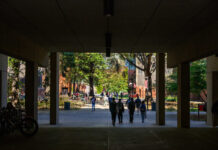Walworth and other music therapy practitioners, however, will tell you that more is happening in this classroom than entertainment.
“Music therapy is a medical and social tool for all ages,” said Walworth, an expert on infant learning and a fellow of the National Institute for Infant and Child Medical Music Therapy.
For people with brain injuries, such as Gabby Giffords, the former Arizona congresswoman who was shot in the head Jan. 8, 2011, music therapy is a way to relearn how to talk.
For people with post-traumatic stress disorder, such as that many Haitian children experienced after the 2010 hurricane, music therapy is a way to regain self-esteem, confidence and hope.
At ELC, a preschool the College of Education and Human Development operates at the Gladys and Lewis “Sonny” Bass Scholar House campus, music therapy is a developmental tool. Walworth and her students structure music activities to stimulate in the children multiple sensory reactions.
“The music engages their vision and hearing, develops motor skills in movement and develops listening skills in following directions and cognitive functioning to enable decision making,” Walworth said.
“We adjust the techniques to meet the needs of each age group,” she explained. “For example, an alphabet song can teach 4 year olds to sing and sign at the same time.”
Music therapy even can help calm the six-week- to six-month-old babies in the ELC infant room.
“Many times several of the infants are fussy and crying when we begin sessions,” Walworth said. “A small 26-string harp is the favorite of the staff. As soon as the infant’s feet are placed on the soundboard and they feel the resulting vibrations of the strings being plucked, the crying stops and smiles usually begin.”
Both the music and the instruments help Walworth and her students to measure milestones in infant development. For example, a multicolored rainstick has a calming sound but also helps music therapy practitioners observe an infant’s hand movement, reaching skills and ability to visually track an object – in this case the colored beads on the instrument.
“Infants who regularly attend music therapy sessions show significantly advanced motor, cognitive and social skills,” said Walworth, whose research focuses on the effects of music therapy in medical and early childhood settings with emphases in medical procedural support, autism treatment and developmental outcomes of premature infants.
Preschool children aren’t the only ones who benefit from music therapy. That is why UofL, which in 2000 established the first music therapy program in Kentucky to educate music therapists, places its students in public schools, trauma centers, hospitals, hospice services and other area sites to gain experience.
“Music has a profound effect on both body and psyche,” Walworth said. “Many hospitals are using music therapists for pain management, to alleviate depression and reduce stress, to promote movement, to reduce time for procedures such as MRI and CT scans and for the many other benefits that music and music therapy can bring.”
Benefits aside, back at ELC, the children dancing to the music know that it is just plain fun.


























